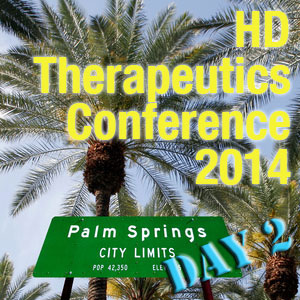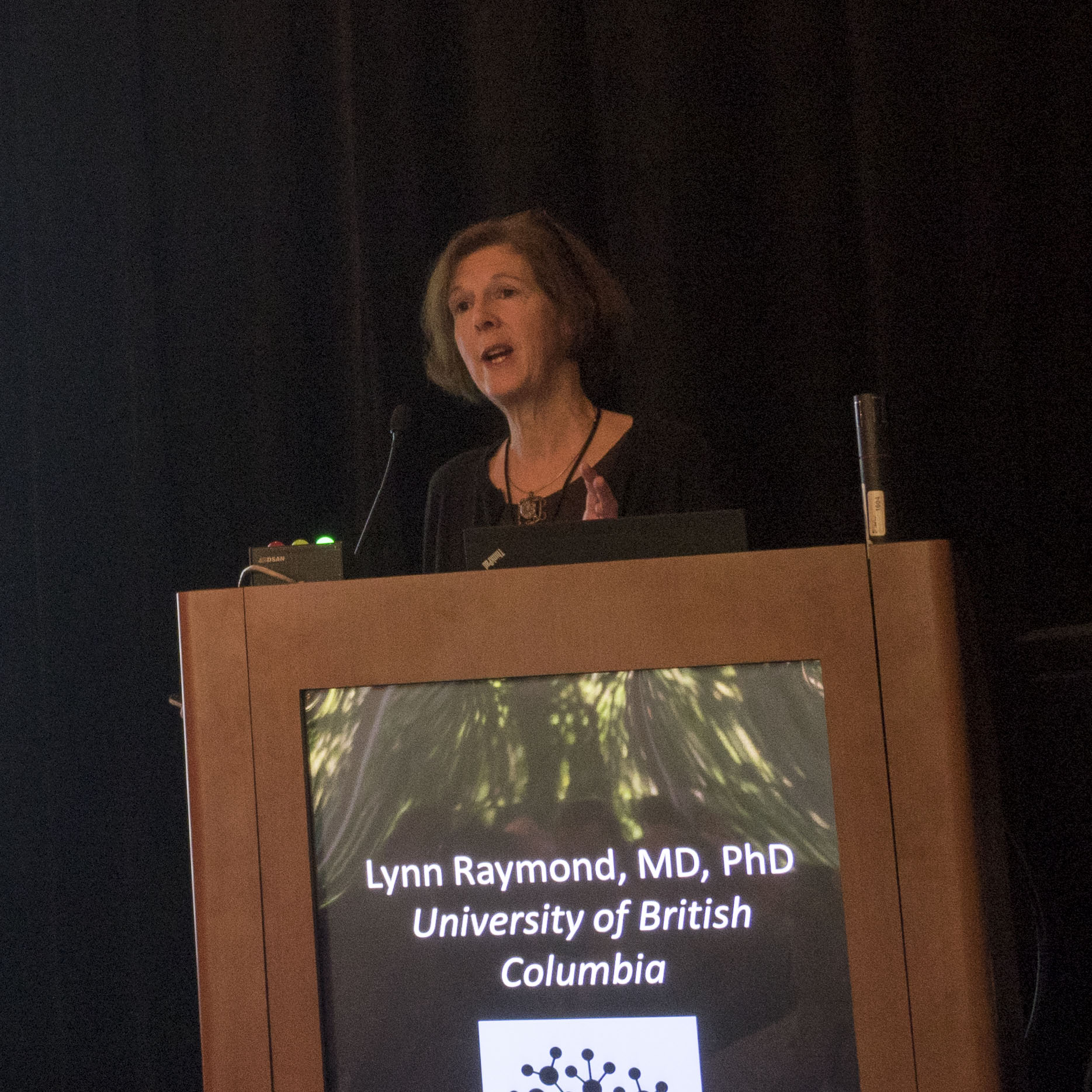
Huntington's Disease Therapeutics Conference 2014: day 2
Cells, circuits and systems: day 2 of the 2014 HD Therapeutics conference

HDBuzz reports from the second day of science at the Huntington’s disease therapeutics conference in Palm Springs.
Morning session: Cells, Circuits and Systems
09:06 – The second day of the annual HD therapeutics conference starts with a series of talks on “Cells, circuits and systems”

But first… watch Olympian & world champion rower Sarah Winckless address the Huntington’s Disease Therapeutics Conference
09:09 – The scientists speaking this morning are interested in communication breakdown in the HD brain and how to fix it
09:14 – Mike Levine, ULCA, explains how the “striatum” is wired together. This is the most vulnerable part of the brain in HD patients
09:18 – The brain is complicated! In HD, degenerating tissues are composed of a wide range of cell types, wired together in complex circuits
09:21 – Bal Khakh, UCLA, studies a star-shaped type of cell called an “astrocyte”. The brain is stuffed with these non-neuronal cells
09:22 – In mice, if we put the mutant HD gene in only astrocytes, the brain gets sick. This got Bal interested in astrocytes in HD patients
09:26 – Though astrocytes don’t fire electrical signals like brain cells called neurons, they have really important functions
09:40 – Could changes in astrocytes in the HD brain contribute to dysfunction in other brain cells? Bal is using HD mice to try to find out
09:43 – In HD mice, fixing astrocyte problems leads to improvement in symptoms
09:51 – Lynn Raymond, UBC, studies changes in a specific “synapse” in the HD brain. Synapses are connections between “neurons” in the brain
09:55 – Raymond measures electrical and chemical activity in these synapses in healthy mice and those with the HD mutation
10:00 – Raymond grows neurons from the cortex (surface of the brain) and striatum (deeper part) together to study how they interact
10:08 – Lynne Raymond addressing the conference on the function of synapses http://t.co/RTyfwMzjZk
10:09 – Raymond has found that there are electrical differences in the behavior of the striatal neurons but it’s not clear why
10:10 – Raymond’s aim is to use the cortex-striatum neuron mixture, called co-culture, to test drugs for HD
10:28 – Next up, Mark Bevan of Northwestern University. Bevan studies the electrical activity in ‘brain slices’ from HD mice.
10:33 – Bevan has found abnormally low activity in a part of the striatum called the subthalamic nucleus in HD mice
10:33 – An electrical switch called the NMDA receptor seems to be responsible for this abnormality.
10:40 – Bevan is trying to figure out why this abnormal activity occurs. Work like this is essential to understanding how to fix human brains
11:17 – Anton Reiner, UT, has a long standing interest in mapping patterns of cell loss in HD patient brains. Which cells are first to go?
“Rebec’s take home message is “improper communication can be dangerous"”
11:22 – Understanding which brain cell type is most vulnerable in HD might help us understand why some cells die and others don’t
11:24 – While Reiner has studied human brain tissues, his lab also works with HD mice to look at very early changes in the HD brain
11:29 – Reiner is working now to try to correlate patterns of change that he sees in HD mouse brains with their behavioral symptoms
11:34 – Reiner is interested in undersanding the origin of a movement symptom called "dystonia” in HD
11:37 – Dystonia, twisted and abnormal movements or postures, can be a debilitating symptom of HD, partricularly in later stages
11:37 – Reiner is studying the connection between patterns of cell loss in the HD brain and the presence of dystonia as a symptom
11:47 – George Rebec, Indiana University, measures the activity of brain cells in HD mice that are awake and behaving
11:49 – His mice wear “headsets” that record brain cell activity while the mice actively move around their cages
11:52 – Like Raymond, and others, Rebec is interested in communication between the “cortex” and “striatum”, and how this goes wrong in HD
11:58 – While observing HD mice, Rebec notices that they don’t like to sit still as much as normal mice, they seem restless
11:59 – Rebec can detect brain activity patterns that correlate with this restlessness, maybe explaining it’s cause
12:01 – He’s using a genetic trick in mice to get rid of the mutant HD gene in the cortex, but not the striatum, to figure out who’s in charge
12:07 – These mice seem a bit less restless, and a bit less “stubborn” in their behavior patterns
12:10 – Rebec’s take home message is “improper communication can be dangerous”, so fixing cortical problems might help other brain areas in HD
Sunset conclusions
This afternoon we took time to view and digest the 100 posters presented by the 300 scientists attending the meeting. These posters represent a huge amount of work from dozens of laboratories around the world. Most is unpublished, much is incredibly innovative and all is shared freely to foster collaboration and accelerate the development of treatments.
After that we heard from James Bradner of the Dana-Farber Cancer Institute. Bradner developed a drug molecule for a rare type of cancer then made the drug freely available to any researcher worldwide, leading to an explosion of therapeutic progress in many other diseases. We recalled Jonas Salk’s response to an interviewer asking whether he’d patent his life-saving polio vaccine: “Could you patent the sun?”
At HDBuzz, we are unashamed fans of sharing and the free flow of information. A spirit of openness runs through the HD scientific and patient community, fertilizing progress towards treatments.
For more information about our disclosure policy see our FAQ…


